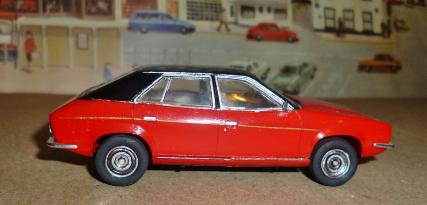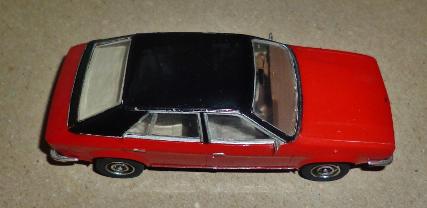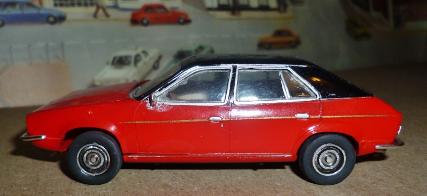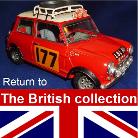
1975 Leyland “Princess”.
The 1960s mergers of so many British car manufacturers produced a collection of competing marques, models, design ideologies and workforces all under the same umbrella. As the old proverb says “a house divided against itself cannot stand”; BMC, and later British Leyland, appear to have been conceived as experiments to prove the adage true.
Austin and Morris hated each other and their workers remained fiercely loyal to “their” brands. Overall management and workers fought against one another with increasing frequency as the 70s rolled on, badge engineering reigned (confusing potential customers), and the companies under the umbrella groups were fighting against each other with models in the same market sectors.
This state of affairs took British motor manufacturing from the huge success of the ground breaking Mini, to the repertoires of stand-up comedians the length and breadth of Britain. The Metro, Maestro, Ambassador and Montego all suffered from the problems at BL which generated adverse feelings in potential customers who saw all the inadequacies of BL management, and overreactions of the unions, play out nightly on the TV news and on the front pages of the mainstream press. Against this backdrop of change, unrest and the beginnings of “the common market” British companies strove to find new markets, and products to fit them. Two such companies, the British Motor Corporation and Leyland, were well aware of the problems facing the British motor industry and were busy looking ways to solidify their futures.
For the British Motor Corporation, the future was seen in the hiring of the American Filmer M. Paradise as director of sales (at Longbridge) in 1967. Paradise had been very effective at Ford and was expected to boost BMCs poor sales in Europe. His approach was just what was needed to lift a miserable, unmotivated company. In his words :-
"I really felt that my reputation preceded me here at Longbridge. I think people were expecting a revolution. They were certainly uneasy. It was a situation which would not have been served properly by barnstorming in and throwing my weight about. Everybody was expecting a lot of firings. Morale was low and I had to nurse it carefully."
To foster a spirit of togetherness, and raise the self-esteem of all employees, Paradise stated trawling the existing staff.
"I was looking for the kind of people ready and able to do things that had never been done before. The pleasant thing is that I found so many."
The result was a team of eight young men all receptive to new ideas and ready to create new trends rather than follow the old ways. All but two of these men were from within BMC (the other two were ex-Ford men) and proved that the company already had what it needed but hadn’t been using the resources in an effective manner.
Leyland’s new man for the future was John Barber. Brought in as director of finance and planning in 1968 Barber was equally as astute as Paradise and he quickly saw that Leyland could not survive on its existing models and sales.
Our subject here can be traced to February 1970 when Filmer Paradise had sent a confidential memorandum about the BMC ADO17 series to the Product Policy Committee at BMC. The substance of which was a repeat of John Barber's thoughts at Leyland. Both were clear that their respective companies needed a model in the “D-segment” of the car market, that is to say the upper-medium sector.
It should also be “Euro-friendly” to be more competitive in the European market place. While this reasoning was, and is, quite straightforward and logical, bringing it to the road would not be so easy. The wedge-shaped wonder we recall here was to come from the BMC side, in particular the design team of Harris Mann. One of Mann’s 1969 designs for a futuristic sports car (which became the BL Zanda shown as a concept car exhibited at the Earls Court Motor Show), received some good responses and the BL board thought there was merit in some of the ideas on the car. As negotiations went on in the merger of BMC, which owned Austin-Morris, and Leyland, which owned Triumph and Rover, the two sides of British Leyland Motor Corporation became ever more integrated. So it was, that Mann and his team were moved from Cowley to Longbridge in 1970 and Harris Mann replaced Roy Haynes as the top man in the design studios.
In keeping with the Paradise vision of something new the Mann design that followed had a look that was echoing the angular styling of the “Boomerang” and “Lotus Esprit” concept sports cars; and, the size fitted with the company’s upmarket aspirations. It could be ‘wedged’ in between the top level Mk3 Cortina and the entry level Granada.
The futuristic Project ADO71 started as a clay model completed at Longbridge in November 1970. The general shape remained remarkably similar even when the car went into production but inevitably there would be some tweaking of the design needed as the mechanicals of the car were decided.
The first was the engine, its height affects the bonnet line level. Original thinking was to use the newer E series engine but sales projection for the Allegro and Maxi suggested there wouldn’t be enough production capacity at the Cofton Hackett plant. As this engine had far less power than the B series motor and the ADO71 was almost as heavy as the ADO17 the older engine was probably a better choice anyway. The O series engine, an OHV upgrade of the B series unit, was on its way so using the B series engine from the start would make conversion to the O series unit easier too.
The origins of the 4-cyl’ B-Series pushrod engine dated back to 1947, although not overly powerful it had reasonable torque and was a proven unit. The larger SOHC straight-6 2227cc E-series motor was a more recent design. It wasn’t really that powerful at just 110bhp but it was very smooth when running.
There were also thoughts of using a 3,500cc V8 engine at some point in the future so the engine bay and bonnet were made big enough to fit such an engine, the space created catering for taller, wider engine options was so large that working on the engines was a joy for mechanics who could almost climb over the wing and stand in the space beside the engine! This consideration also led to the windscreen wipers being nicely tucked away out of sight under the rear lip of the bonnet, all accentuating the wedge shape.
Having little in the way of power from the engines the use of a 4-speed gearbox didn’t help in the performance area. A 5-speed unit might have been better for top speed and economy but the shortages of money didn’t allow for any development. A Borg-Warner automatic transmission was available as an option on some models but it was exactly sporty either.
Chassis and suspension development teams were under the tutelage of Charles Griffin, and followed the Hydragas suspension system used on the Allegro. Mechanically similar to the front suspension on the Maxi, and with the spring rates kept exceptionally soft the ride of the ADO71 was excellent. The decision to fit wide, low profile tyres with lower tyre pressures (utilised the flexing of the tyres’ sidewalls giving even more softness to the ride), made the overall driving experience very enjoyable.
The front wheel drive system remained as a ‘carryover’ from earlier Austin-Morris cars as the company had championed the cause for so long that to return to rear wheel drive would send the wrong message to the buying believers. This, and the wedge design, gave “class-leading passenger space” yet, in keeping with BMC traditions, the car had relatively short overhangs. The rear passengers might have had slightly less space than in the previous ADO17 design but the new driving position was far more reclined and comfortable in comparison to the Austin-Morris 1800 “landcrab” it was replacing, also of note for the driver was the “futuristic” look of the far more ergonomic dashboard. BL had even listened to the ADO17 customers moans about its heavy steering, they fitted power assisted steering as standard on the 2200 and as an optional extra on the lower range models.
Another plus was the larger body size allowed improved design of crash protection structures and the larger boot. However, the boot was to become a sphere of contention throughout the Princess’ life. Harris Mann had designed the car with a hatchback so it could better compete against European cars such as the Renault 20 or the Audi 100 Avant, but the product planners at BMC thought differently. They believed the middle market Maxi hatchback had that area covered and the Rover SD1 covered the higher market so there was little point in creating another hatchback that would then compete with existing cars under the same umbrella company.
When the 18-22 Series launched this decision was explained in a statement, part of which said:
‘The Engineering Department was also encouraged to shy away from creating the car as five-door model because it would have added extra weight and complexity, with only marginal improvements in accommodation. Market research for BLMC also indicated that a saloon was what customers wanted.’
So, they gave the car a fixed rear window and a boot. A big enough boot to be sure, but a boot with a limited opening space and a lid that always seem to get in the way when you needed to put something in or take something out. Not having a hatchback hurt sales of the Princess throughout its production. The Princess could have been given great load space options with the interior space available, utilising folding rear seats and full hatchback. To be fair there was a proposal to design an estate version but the concept appears to have been lost somewhere along the way. Interestingly, while the planners at BLMC didn’t think a hatchback was worth the effort other companies saw promise in the Princess. Crayford Engineering and Torcars both offered conversions to an estate and Woodall-Nicholson stretched the Princess to create stretched limousines and hearses.
Harris Mann continued tuning the shape in a wind tunnel and found it needed very little change from the original plan. Aerodynamically the clean, angular shape with high rear and fastback tail end worked really well giving a coefficient of drag figure of cd0.404. Happy with the results the design department knocked up a full-sized version to show the board.
If the distinctive, innovative, and somewhat divisive styling was following the trends set by Italian designers, it also had proper design thought behind it. The high rear of the roof had a more acutely raised section to combat and reduced aerodynamic lift at speed. All angles and slanting panels the car was a good-looking design even though it quickly became known as "The Wedge". BL workers would later have another name for it; "The Anteater".
The AD071 project became the Austin / Morris / Wolseley 18–22 Series upon presentation to the industry press on the 13th of February 1975. The 18–22 designation in the new cars title refers to the engine sizes available, either the 1800cc or 2200cc B-series engines. Managing Director of the Austin-Morris division, Keith Hopkins, explained the situation the company was facing and that competition, particularly from overseas companies, was fierce.
“What we are doing is a recognition of the fact that with an Austin Morris output of below one million cars a year it is just not sensible or realistic for us to try to compete head on with those of our international competitors who have output potentials twice or three times as big as ours” …… “We shall be seeking to create little niches in the world marketplace which are more profitable for us.”
In short, he suggested that Austin-Morris was not dropping out of volume car manufacturing but intended to continuously raise quality and engineering standards for which the knowledgeable buying public would be willing to pay a little more. By seeking out new niche markets Austin-Morris could maintain an image as a market leader and grow its business.
Public presentation was on the 26th of March 1975 under the headlines "the car that has got it all together". Harris Mann’s wedge-shaped design was a model the company felt proud of, the test now was how it would stand up to mainstream press and public opinion. The 18–22 Series was, in this respect a hit. While many had called the Allegro ugly and feared the prospect of another disappointing BLMC design the new car was welcomed as a good-looking and interesting car. Critical acclaim followed with “Motor” magazine even calling the series "the first of Leyland's saviour models". The handling of the front-wheel drive car was optimised the ride quality was very good and high speed stability was impressive. It was the reception the company had been looking for. When Daily Express correspondent David Benson spoke with Harris Mann the designer explained his teams thinking on the design:
“We set out to build a new truly international car, not a scaled down American car, but a car that would have a distinctive flavour and would sell well in this country and Europe. The wedge shape was inspired by Grand Prix cars but it is also very practical as it has been proved on the race track. It gives better penetration through the air and, in our case, better fuel consumption. I also wanted the car to look firm and eager even when parked at the kerb. It is built with its wheels out to the full width of the body, sitting firmly on the ground rather than pouring over the wheels as American cars do.”
Dealers felt a sense of optimism, and relief, as the Allegro never got near outselling the ADO16 it replaced but the public seemed to like the new car and there was an almost palpable belief that the 18-22 series would sell much better than the ADO17 “landcrab” it was replacing. Even BLMC was caught up in a wave of optimism. British Leyland announced:
“We don’t want to crow too early, but motorists’ initial response has been so good that we are all getting a little excited about the car’s prospects.”
This belief exaggerated their own sales and prompted BLMC to seriously modernise the “Cowley North” works in order to be able to meet the expected demand.
For six months after the launch this new phenomenon on the British roads was sold under three marques, the budget level Austin, the Morris and the top of the range Wolseley. The Austin was actually closest to the original concept in overall shape having a simple front grill and eye-catching trapezoidal headlights. The Morris and Wolseley had a more stylized, taller, front radiator grill leading to a raised central section in the bonnet, the Morris having their logo in the lower right-hand corner.
The Wolseley was a real "luxury" model complete with the traditional illuminated logo on the grill, dual headlights either side of it, a six-cylinder engine under the bonnet, luxury carpeting, wood veneer and velour trim inside. Even here the company let itself down, the Wolseley had a fashionable seat belt warning light and a rear cigarette lighter, but no rev’ counter.
This three-brand policy did cause some confusion amongst the buying public and the motoring press. Lord Donald Stokes, boss of British Leyland Motor Corporation, had stated earlier that with the merging of BMC and Leyland being so far advanced the practice of badge engineering would no longer be carried out. All the same, here was ostensibly the same car under three different badges; something that caused no less of a headache for the marketing department who had to justify the issue and somehow spin it as a positive thing for each model.
“Autocar” magazine tested a 2200HL model and seemed to present a pleasantly favourable view of the car. They expressed the belief that this “most satisfactory car” would “find wide favour” amongst business men and those with growing families. On the face of it British Leyland’s low morale level would soon be a thing of the past. However, “Autocar” had not mentioned the cars lack of performance. 0-60mph in 13.5 sec’s was not competitive with similar class cars from rival brands, and, if that time was astonishingly slow then the 50-70mph acceleration (in 4th gear) was a stunningly slow 13.2 seconds. A top speed of 104mph didn’t turn heads in the target class either and the fuel consumption was a woeful 20.7mpg; something very important in those 1970s, oil crisis times. As for the pricing, a like for like model from Ford would cost, including taxes, £2,221; the Austin was noticeably higher £2,424.
Still, things looked good for BLMC with dealers reporting a large volume of interested customers visiting the showrooms. Predictions that the car would be the best-selling British large saloon ever started to fly around fuelled by quotes from the one of the largest BLMC distributors, Mann Egerton :
“We now have a car which, because of its advanced styling and comprehensive equipment, is more than a match for the importers. And at £2100 it is very competitively priced.”
“We can sell every 1800/2200 we can get, but naturally we are being a little careful about the type of car we are taking in part exchange.”
“We are being offered Peugeots, Citroëns and BMWs in part exchange for the new car. These are normally regarded as being up market of the Austin Morris range.”
Since 1968 BLMC had been restructuring Austin-Morris dealerships with those of Rover and Triumph, by September 1975 this was now well advanced. After the Ryder Report recommendations that BLMC should be a single unified car company the dropping of badge engineering commenced and the management, remaining very proud of their new car, rather hastily changed the name of the series to “Princess”. Where there had been seven 18–22 series models sold as Austin/Morris/Wolseley there would now be three models on sale; the economy low-line (L), the high-line (HL) and top of the range high-line super (HLS), making the “Princess” a Marque in its own right. Sadly, this meant the end of the road for the Wolseley name and the last of this once great brand rolled off the production line on the 11th of September 1975.
We can now see why the “Austin” Princess is a regularly repeated mistake. Austin-Morris had a wedge shaped 1800/2000 range, the “Princess” was a British Leyland range; although it was marketed in New Zealand as an Austin and when the later revamped Ambassador went on sale it too went back under the Austin banner. In short, turning a trim range into a marque proved far harder than turning the Wolseley Marque into the highest Austin-Morris trim range.
The new version of the car had a crown badge set at the point of the bonnet and a "Princess" script logo set onto the grille. Those fat vinyl-clad C-pillars also bore the “Princess” script as did the boot. In a styling swap the 1800 cars now had the twin headlights and the 2200 models the lights that Harris Mann had originally designed. The top of the range Princess 2200 HLS Automatic was a nice car. Spacious, well-appointed and with better ride and handling than most of the competition, but it was still a BL product and in the 1970s that meant problems.
While the modern styling was something many people liked they didn’t like the unreliability. Driveshaft failures and collapsing suspensions were major concerns and the poor build quality (which caused leaking boot and door seals) really annoyed customers.
One fitter from the Cowley plant is quoted as saying:
“The question of quality on the Princess was, in the beginning, really bad. The main problem was bad fit up of parts, and poor colour matching of internal trim. This improved fairly quickly once the launch of the car was done.”
Another Cowley assembly line workers quote was:
“The other problem was the product mix, i.e. low-line, medium-line and high-line trim levels; this was on the Austin and Morris versions. Many wrong parts were fitted to the early cars just to make up the numbers for launch. Once the 18-22 Series was dropped ….. quality improved…”
The company actually reacted quickly even though hamstrung by limited finances. BL brought in Brigadier Charles Maple, from outside the firm, to raise quality to as high a level as possible. The new ‘quality control overlord’ soon had things in hand and the spectacular, public failure of the model actually helped him as he used the workers original pride in the product in his motivational appeals. Unfortunately, the nightmare stories of the government funded company wasting taxpayers' money on failing and abysmal products was nightly news; and despite a very real improvement in quality and reliability the Princess’, and the company’s, reputation plummeted further. Even the once heralded modern styling was reduced to comic comments about wedges of cheese and some critics calling the car “simply ugly”. A Parker's Car Price Guide in the 1990s went so far as to comment that “the people responsible for designing the front and rear of the car were not speaking to one another”.
Worst of all, customers hated the delivery delays! If the 18-22/Princess was the most desirable new car of 1975 it mattered very little when you couldn’t actually get one. Constant industrial disputes, not only on the BL production lines but on the ancillary lines and amongst suppliers too, took its toll of paying customers lining up at the dealers for their new car. British Leyland’s sales expectations were never even close to being met and the car that (like many others before it) was supposed to save BL became another flop.
BL did try a continuous development ideology and to try and force their way back into the private-hire taxi arena produced a run of 50 diesel-powered Princesses in 1977. Although the trial of the Princess 1800D wasn’t overly successful things like improved bulkhead insulation for the noisy B-Series diesel engines was carried over onto the “Princess 2” model of 1978.
Princess 2
By July 1978 BL made enough improvements to reintroduce the car as the “Princess 2”. It had new nylon upholstery colour options and go-faster stripes but the only major change was the long-overdue O-Series engine. Available in 1695cc and 1993cc forms it ran alongside the existing 2.2 E6 power unit. But in truth these were cosmetics, papering over the cracks, and the OHC engine with “improved power” was anything but a smooth powerful motor. The OHC engine had even less pulling power than the older BMC motors and far from providing a more modern sporty feeling reduced the car to the motoring equivalent of a portly middle-aged man. Part of the reason was the reduction to 1700cc capacity to avoid the then 1800 cc tax barrier for company cars.
Two years later, sales having had another hit because of the Iranian problems and its effects on the oil prices, BL’s last roll of the dice was to launch a new ad’ campaign with the slogan “Not the car for Mr. Average”. In a test by “What Car?” magazine in 1980 a 2000HLS stood up quite well against some rather obscure rivals saying,
“It may not be the most prestigious, attractive or advanced alternative available, but for the motorist who places practicality above speed and excitement it must be still the best bet.”
They also described it as:
"An excellent car, marred only by poor reliability".
Sadly, during the early 1980s Princess models continued to sit in dealer showrooms; some for as long as 14 months. Having reached a total production figure of 224,942 units the halt to production was finally called in November 1981 and the Princess was consigned to history with no definitive answer on the question of whether it was a good car or not.
The fact that the follow-on reincarnation model, the Ambassador, was in production for just two years, and sales were so poor BL never made a left-hand-drive model, suggest the design was the problem; but most historians today lean toward the car being a victim of the trials and tribulations of the era. The reputation of BL (terrible industrial relations, technical inadequacies, and no funds for development), were a millstone around the neck of sales that could not be shaken off.
Today there is a strong band of followers who love the “Princess” and the epitaph a “memorable product of a forgettable period in British motor manufacturing” is as accurate as could be. Had the full potential of the design been exploited and the quality been tip-top from the start then perhaps the “Princess” would have been a Queen, or at least Princess Royal.










Heller released their kit of the “Leyland Princess 2000” in 1979, Heller catalogue # 180. It might only be in 1/43rd scale but it has huge visual impact, just as the original car did when it was first presented to the press. The photo’s of the model show what lovely kits these Heller offerings are and what potential they could have today.
Rod built this model around 1980 and it is now showing its age. The brush applied Humbrol silver paint has rubbed off noticeably and several repairs have detracted from the model’s former good looks. In keeping with our ethos though we show our model as portraying the learning curve of the modeller, and the evolution of the hobby. Humbrol enamel paints, applied with a brush, was the norm back then. Undoubtedly, a model built from this kit today would look immeasurably better as we have spray paints, bare metal foil and far better finishing products.
